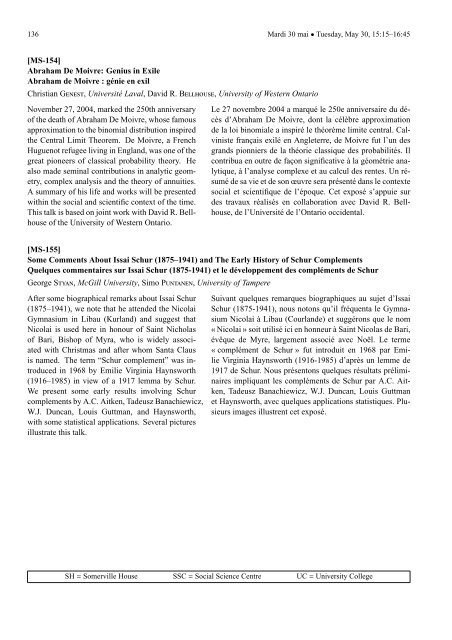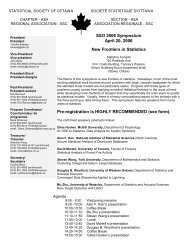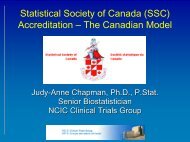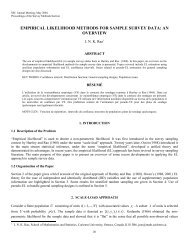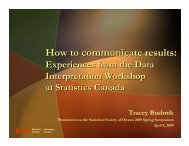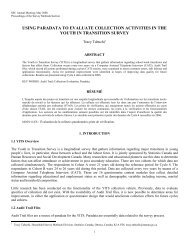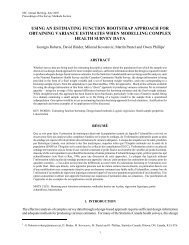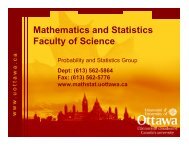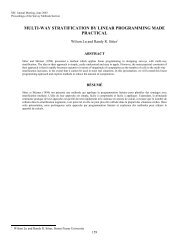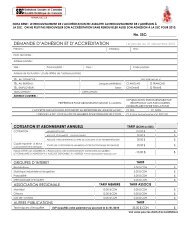136 Mardi 30 mai • Tuesday, May 30, 15:15–16:45[MS-154]Abraham De Moivre: Genius in ExileAbraham de Moivre : génie en exilChristian GENEST, Université Laval, David R. BELLHOUSE, University of Western OntarioLe 27 novembre 2004 a marqué le 250e anniversaire <strong>du</strong> décèsd’Abraham De Moivre, dont la célèbre approximationde la loi binomiale a inspiré le théorème limite central. Cal-viniste français exilé en Angl<strong>et</strong>erre, de Moivre fut l’un desgrands pionniers de la théorie classique des probabilités. Ilcontribua en outre de façon significative à la géométrie ana-lytique, à l’analyse complexe <strong>et</strong> au calcul des rentes. Un ré-sumé de sa vie <strong>et</strong> de son œuvre sera présenté dans le contextesocial <strong>et</strong> scientifique de l’époque. C<strong>et</strong> exposé s’appuie surdes travaux réalisés en collaboration avec David R. Bellhouse,de l’Université de l’Ontario occidental.November 27, 2004, marked the 250th anniversaryof the death of Abraham De Moivre, whose famousapproximation to the binomial distribution inspiredthe Central Limit Theorem. De Moivre, a FrenchHuguenot refugee living in England, was one of thegreat pioneers of classical probability theory. Healso made seminal contributions in analytic geom<strong>et</strong>ry,complex analysis and the theory of annuities.A summary of his life and works will be presentedwithin the social and scientific context of the time.This talk is based on joint work with David R. Bellhouseof the University of Western Ontario.[MS-155]Some Comments About Issai Schur (1875–1941) and The Early History of Schur ComplementsQuelques commentaires sur Issai Schur (1875-1941) <strong>et</strong> le développement des compléments de SchurGeorge STYAN, McGill University, Simo PUNTANEN, University of TampereAfter some biographical remarks about Issai Schur(1875–1941), we note that he attended the NicolaiSuivant quelques remarques biographiques au suj<strong>et</strong> d’IssaiSchur (1875-1941), nous notons qu’il fréquenta le Gymna-Gymnasium in Libau (Kurland) and suggest that sium Nicolai à Libau (Courlande) <strong>et</strong> suggérons que le nomNicolai is used here in honour of Saint Nicholas « Nicolai » soit utilisé ici en honneur à Saint Nicolas de Bari,of Bari, Bishop of Myra, who is widely associ- évêque de Myre, largement associé avec Noël. Le termeated with Christmas and after whom Santa Claus « complément de Schur » fut intro<strong>du</strong>it en 1968 par Emiisnamed. The term “Schur complement” was in- lie Virginia Haynsworth (1916-1985) d’après un lemme d<strong>et</strong>ro<strong>du</strong>ced in 1968 by Emilie Virginia Haynsworth 1917 de Schur. Nous présentons quelques résultats prélimi-(1916–1985) in view of a 1917 lemma by Schur. naires impliquant les compléments de Schur par A.C. Ait-We present some early results involving Schur ken, Tadeusz Banachiewicz, W.J. Duncan, Louis Guttmancomplements by A.C. Aitken, Tadeusz Banachiewicz, <strong>et</strong> Haynsworth, avec quelques applications <strong>statistique</strong>s. Plu-W.J. Duncan, Louis Guttman, and Haynsworth, sieurs images illustrent c<strong>et</strong> exposé.with some statistical applications. Several picturesillustrate this talk.SH = Somerville House SSC = Social Science Centre UC = University College
Mardi 30 mai • Tuesday, May 30, 15:15–16:45 137Session 08E Mardi 30 mai • Tuesday, May 30, 15:15–16:45 UC85Estimating Function M<strong>et</strong>hodologyMéthodologie d’estimation de fonctions[MS-156]Information Matrix: From Fisher to GodambeMatrices d’information : de Fisher à GodambeP<strong>et</strong>er SONG & Qian ZHOU, University of WaterlooEn théorie de l’estimation fonctionelle, la matrice d’informationde Godambe est au cœur de la description de la nor-malité asymptotique d’un estimateur. Lors de c<strong>et</strong> exposé, jeprésenterai des études empiriques afin de démontrer les mé-rites de la matrice d’information de Godambe par rapport à lamatrice d’information de Fisher dans le cadre de l’inférencebasée sur le maximum de vraisemblance (MV). Bien que lamatrice d’information de Godambe se ré<strong>du</strong>ise à la matriced’information de Fisher dans le contexte MV, sa construc-tion unique de type sandwich perm<strong>et</strong> une meilleure robus-tesse par rapport aux données influentes <strong>et</strong> à une mauvaisespécification <strong>du</strong> modèle. Les résultats de plusieurs études desimulation seront exposés lors de la présentation.In the theory of estimating functions, Godambe informationmatrix is the essence in the descriptionof asymptotic normality for an estimator. In thistalk I will present some empirical studies to demonstratemerits of Godambe information matrix overthe Fisher information matrix in the maximum likelihood(ML) inference. Although Godambe informationmatrix re<strong>du</strong>ces to Fisher Information matrixin the ML s<strong>et</strong>ting, its unique sandwich-typeconstruction gives rise to some desirable robustnessagainst influential data points and model misspecification.Results from several simulation studieswill be given in the presentation.[MS-157]Estimating Functions and Analysis of Missing DataFonctions d’estimation <strong>et</strong> analyse des données manquantesBent JØRGENSEN, University of Southern DenmarkNous passons en revue des résultats de base concernantl’optimalité de fonctions estimatrices, tels l’optimalité deGodambe <strong>et</strong> de Crowder pour les fonctions de cotes <strong>et</strong> lesquasi-fonctions de cotes, respectivement. Nous révisons éga-lement quelques notions d’orthogonalité des paramètres, <strong>et</strong>intro<strong>du</strong>isons l’idée d’insensibilité aux paramètres de nuisance(Jørgensen <strong>et</strong> Knudsen, Scand. J. Statist. 2004). Cesrésultats sont alors appliqués à l’analyse de données man-quantes dans le contexte des fonctions d’estimation, où nousdiscuterons d’EEG pondérées par probabilités inverses <strong>et</strong> del’utilisation <strong>du</strong> « BLUP » pour l’imputation de données manquantes.We first review basic results for optimality of estimatingfunctions, such as Godambe and Crowderoptimality of the score and quasi-score functions,respectively. We also review some basic notionsof param<strong>et</strong>er orthogonality, and intro<strong>du</strong>ce the ideaof nuisance param<strong>et</strong>er insensitivity (Jørgensen andKnudsen, Scand. J. Statist. 2004). These resultsare then applied to the analysis of missing data inthe context of estimating functions, where we discussinverse probability weighted GEE, and the useof the BLUP for imputation of missing data.[MS-158]Estimating Functions for Correlated Recurrent and Terminal EventsFonctions d’estimation pour évènements récurrents <strong>et</strong> terminaux corrélésJack KALBFLEISCH, Yining YE & Douglas SCHAUBEL, University of MichiganDans les études cliniques <strong>et</strong> observationelles, des évènementsrécurrents (par exemple, des hospitalisations) <strong>et</strong> ter-minaux (par exemple, la mort) sont fréquemment rencon-In clinical and observational studies, recurrentevent data (e.g., hospitalizations) with a terminalevent (e.g., death) are often encountered. In manySH = Somerville House SSC = Social Science Centre UC = University College
- Page 1 and 2:
3Table of Contents • Table des ma
- Page 3 and 4:
Welcome • Bienvenue 5détails sur
- Page 5 and 6:
7Organizers • OrganisateursLocal
- Page 7 and 8:
General Information • Information
- Page 9 and 10:
General Information • Information
- Page 12 and 13:
14 Committees and Meetings • Comi
- Page 14 and 15:
16 Committees and Meetings • Comi
- Page 16 and 17:
18 List of Sessions • Liste des s
- Page 18 and 19:
20 List of Sessions • Liste des s
- Page 20 and 21:
22 List of Sessions • Liste des s
- Page 22 and 23:
24 Dimanche 28 mai • Sunday, May
- Page 24 and 25:
26 Lundi 29 mai • Monday, May 29,
- Page 26 and 27:
28 Lundi 29 mai • Monday, May 29,
- Page 28 and 29:
30 Lundi 29 mai • Monday, May 29,
- Page 30 and 31:
32 Lundi 29 mai • Monday, May 29,
- Page 32 and 33:
34 Lundi 29 mai • Monday, May 29,
- Page 35 and 36:
Mardi 30 mai • Tuesday, May 30, 1
- Page 37 and 38:
Mardi 30 mai • Tuesday, May 30, 1
- Page 39 and 40:
Mardi 30 mai • Tuesday, May 30, 1
- Page 41 and 42:
Mardi 30 mai • Tuesday, May 30, 1
- Page 43 and 44:
Mardi 30 mai • Tuesday, May 30, 1
- Page 45 and 46:
Mardi 30 mai • Tuesday, May 30, 1
- Page 47 and 48:
Mardi 30 mai • Tuesday, May 30, 1
- Page 49 and 50:
Mercredi 31 mai • Wednesday, May
- Page 51 and 52:
Mercredi 31 mai • Wednesday, May
- Page 53 and 54:
Mercredi 31 mai • Wednesday, May
- Page 55 and 56:
Mercredi 31 mai • Wednesday, May
- Page 57 and 58:
Mercredi 31 mai • Wednesday, May
- Page 59 and 60:
61Abstracts • RésumésSession 0
- Page 61 and 62:
Dimanche 28 mai • Sunday, May 28,
- Page 63 and 64:
Lundi 29 mai • Monday, May 29, 08
- Page 65 and 66:
Lundi 29 mai • Monday, May 29, 10
- Page 67 and 68:
Lundi 29 mai • Monday, May 29, 10
- Page 69 and 70:
Lundi 29 mai • Monday, May 29, 10
- Page 71 and 72:
Lundi 29 mai • Monday, May 29, 10
- Page 73 and 74:
Lundi 29 mai • Monday, May 29, 10
- Page 75 and 76:
Lundi 29 mai • Monday, May 29, 10
- Page 77 and 78:
Lundi 29 mai • Monday, May 29, 10
- Page 79 and 80:
Lundi 29 mai • Monday, May 29, 10
- Page 81 and 82:
Lundi 29 mai • Monday, May 29, 13
- Page 83 and 84: Lundi 29 mai • Monday, May 29, 13
- Page 85 and 86: Lundi 29 mai • Monday, May 29, 15
- Page 87 and 88: Lundi 29 mai • Monday, May 29, 15
- Page 89 and 90: Lundi 29 mai • Monday, May 29, 15
- Page 91 and 92: Lundi 29 mai • Monday, May 29, 15
- Page 93 and 94: Lundi 29 mai • Monday, May 29, 15
- Page 95 and 96: Lundi 29 mai • Monday, May 29, 15
- Page 97 and 98: Lundi 29 mai • Monday, May 29, 15
- Page 99 and 100: Mardi 30 mai • Tuesday, May 30, 0
- Page 101 and 102: Mardi 30 mai • Tuesday, May 30, 1
- Page 103 and 104: Mardi 30 mai • Tuesday, May 30, 1
- Page 105 and 106: Mardi 30 mai • Tuesday, May 30, 1
- Page 107 and 108: Mardi 30 mai • Tuesday, May 30, 1
- Page 109 and 110: Mardi 30 mai • Tuesday, May 30, 1
- Page 111 and 112: Mardi 30 mai • Tuesday, May 30, 1
- Page 113 and 114: Mardi 30 mai • Tuesday, May 30, 1
- Page 115 and 116: Mardi 30 mai • Tuesday, May 30, 1
- Page 117 and 118: Mardi 30 mai • Tuesday, May 30, 1
- Page 119 and 120: Mardi 30 mai • Tuesday, May 30, 1
- Page 121 and 122: Mardi 30 mai • Tuesday, May 30, 1
- Page 123 and 124: Mardi 30 mai • Tuesday, May 30, 1
- Page 125 and 126: Mardi 30 mai • Tuesday, May 30, 1
- Page 127 and 128: Mardi 30 mai • Tuesday, May 30, 1
- Page 129 and 130: Mardi 30 mai • Tuesday, May 30, 1
- Page 131 and 132: Mardi 30 mai • Tuesday, May 30, 1
- Page 133: Mardi 30 mai • Tuesday, May 30, 1
- Page 137 and 138: Mardi 30 mai • Tuesday, May 30, 1
- Page 139 and 140: Mardi 30 mai • Tuesday, May 30, 1
- Page 141 and 142: Mardi 30 mai • Tuesday, May 30, 1
- Page 143 and 144: Mercredi 31 mai • Wednesday, May
- Page 145 and 146: Mercredi 31 mai • Wednesday, May
- Page 147 and 148: Mercredi 31 mai • Wednesday, May
- Page 149 and 150: Mercredi 31 mai • Wednesday, May
- Page 151 and 152: Mercredi 31 mai • Wednesday, May
- Page 153 and 154: Mercredi 31 mai • Wednesday, May
- Page 155 and 156: Mercredi 31 mai • Wednesday, May
- Page 157 and 158: Mercredi 31 mai • Wednesday, May
- Page 159 and 160: Mercredi 31 mai • Wednesday, May
- Page 161 and 162: Mercredi 31 mai • Wednesday, May
- Page 163 and 164: Mercredi 31 mai • Wednesday, May
- Page 165 and 166: Mercredi 31 mai • Wednesday, May
- Page 167 and 168: Mercredi 31 mai • Wednesday, May
- Page 169 and 170: Mercredi 31 mai • Wednesday, May
- Page 171 and 172: Mercredi 31 mai • Wednesday, May
- Page 173 and 174: Mercredi 31 mai • Wednesday, May
- Page 175 and 176: Mercredi 31 mai • Wednesday, May
- Page 177 and 178: 179Author Index • Index des auteu
- Page 179 and 180: Author Index • Index des auteurs
- Page 181 and 182: Author Index • Index des auteurs
- Page 183 and 184: Author Index (per session) • Inde
- Page 185 and 186:
Author Index (per session) • Inde
- Page 187:
Author Index (per session) • Inde


